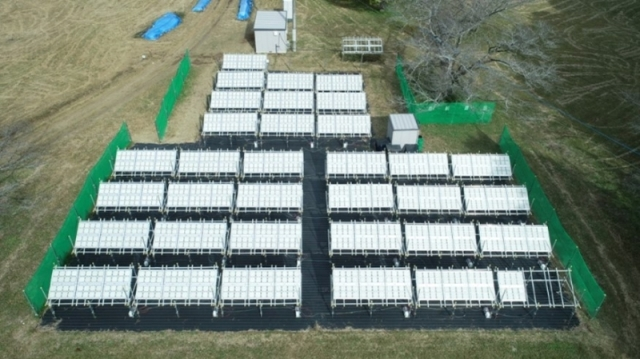

NEDO:人工光合成でソーラー水素製造:光触媒パネル反応システム(動画):
NEDO: Solar hydrogen production by Photocatalytic panel reaction system:
NEDO:通过人工光合作用生产太阳能:光催化面板反应系统
2021年8月26日
NEDO:
人工光合成化学プロセス技術研究組合(ARPChem):人工光合成システムの社会実装に向け、光触媒パネル反応システムを開発した。
東京大学、
富士フイルム(株)、
TOTO(株)、
三菱ケミカル(株)、
信州大学、
明治大学とともに、世界で初めて、実証試験に成功しました。
光触媒パネル反応システム:
- 100㎡の太陽光受光型光触媒パネル反応器と、
- 水素・酸素ガスガス分離モジュールを連結し、
光触媒パネル反応システムを開発しました。
高純度ソーラー水素を分離・回収:
- 水を分解し生成した水素と、
- 酸素の混合気体混合気体から、
高純度のソーラー水素を分離・回収することに成功しました。
ソーラー水素製造の安全設計:
さらに、ガス流路を適切に設計しました。
混合気体を長期間安全に取り扱えることを確認。
ソーラー水素製造光触媒パネル反応システムの大規模化や、
ソーラー水素製造の安全設計の実現に寄与します。
今回の研究成果:
2021年8月25日(水)に英国科学誌「Nature」のオンライン速報版で公開されました。
光触媒パネル反応器:
「屋外環境で、継続して1年間、水素と酸素の混合気体が発生すること」を確認しました。
夏の日照条件が良好な時期には、「最大0.76%の太陽光エネルギー変換効率」を達成。
変換効率 5~10%を目指す:
今回用いた光触媒は、紫外光しか吸収しません。
その為、太陽光エネルギー変換効率は、1%未満と低い値にとどまっています。
可視光と紫外光吸収型の光触媒:
今後数年以内に、可視光と紫外光の両方を吸収できる光触媒を開発します。
5~10%の達成を目指しています。
NEDO
https://www.nedo.go.jp/news/press/AA5_101473.html
Photocatalytic solar hydrogen production from water on a 100 m2-scale
Abstract
The unprecedented impact of human activity on Earth’s climate and the ongoing increase in global energy demand
have made the development of carbon-neutral energy sources ever more important.
Hydrogen is an attractive and versatile energy carrier (and important and widely used chemical)
obtainable from water through photocatalysis using sunlight, and through electrolysis driven by solar or wind energy1,2.
The most efficient solar hydrogen production schemes, which couple solar cells to electrolysis systems,
reach solar-to-hydrogen (STH) energy conversion efficiencies of 30% at a laboratory scale3.
Photocatalytic water splitting reaches notably lower conversion efficiencies of only around 1%,
but the system design is much simpler and cheaper and more amenable to
scale-up1,2—provided the moist, stoichiometric hydrogen and oxygen product mixture can be handled safely in a field environment and the hydrogen recovered.
Extending our earlier demonstration of a 1 m2 panel reactor system based on a modified, aluminium-doped strontium titanate particulate photocatalyst4,
we here report safe operation of a 100 m2 array of panel reactors over several months with autonomous recovery of hydrogen from the moist gas product mixture using a commercial polyimide membrane5.
The system, optimized for safety and durability and remaining undamaged upon intentional ignition of recovered hydrogen, reaches a maximum STH of 0.76%.
While the hydrogen production is inefficient and energy negative overall,
our findings demonstrate that safe, large-scale photocatalytic water splitting and gas collection and separation are possible.
To make the technology economically viable and practically useful,
essential next steps are reactor and process optimization to substantially reduce costs and improve STH efficiency, photocatalyst stability and gas separation efficiency.
Nature